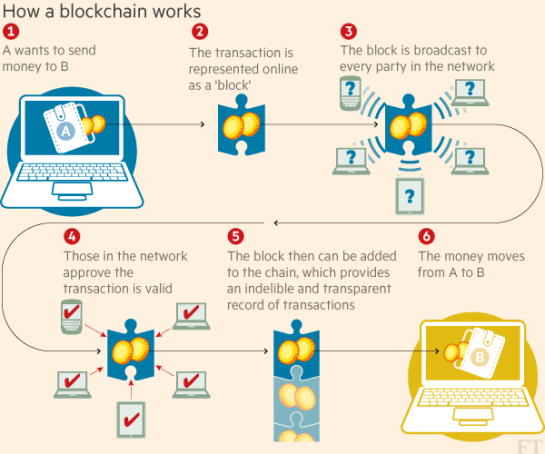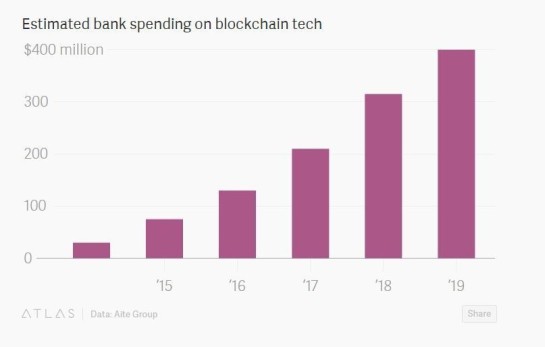A Blockchain is a digital platform that hosts a digital ledger of transactions and shares it among a distributed network of computers. The cryptography technology allows each participant on the network to manipulate the ledger in a secure way without the need for a central authority. Once a block of data is recorded on the Blockchain ledger, it’s extremely difficult to change or remove. When someone wants to add to it, participants in the network — all of which have copies of the existing Blockchain — run algorithms to evaluate and verify the proposed transaction. If a majority of nodes agree that the transaction looks valid — that is, identifying information matches the Blockchain’s history — then the new transaction will be approved and a new block added to the chain.

Image: Financial Times
A report from financial technology consultant Aite estimated that banks spent $75 million last year on blockchain. And Silicon Valley venture capitalists are also queuing up to back it.

Bitcoin’s Blockchain is often touted as a revolutionary step forward for network security. But August’s theft of nearly $68 million of customers’ bitcoins from a Hong-Kong-based exchange demonstrated that the currency is still a big risk.
The very Fact that all Bitcoin transactions are permanent and cannot be undone, gives hackers a free hand to steal Bitcoins and get away with it. In fact, there are a few clever tricks built in Bitcoin System so that altering a ledger entry in the blockchain invalidates all subsequent entries. So It is Practically Impossible to Undo Payments in this case “Stolen Bitcoins” unless the hacker himself agrees to return the stolen Bitcoins. There are basically two ways a hacker could hack Bitcoin System for Stealing Bitcoins. He is either able to get the Blockchain password (Wallet key) of a User or a group of user and then use it to transfer all bitcoins from users wallet to his Anonymous Wallet. Or he could actually Hijack Bitcoin Mining Pool and redirect all of its computing power to Mine Bitcoins for himself.
Kaspersky Labs and INTERPOL have presented research in which they show how blockchain-based cryptocurrencies can potentially be abused with arbitrary data that can be disseminated through its public decentralized databases. An attack on “The DAO” took place on 17th June 2016. However, believe it or not, the developers did know of the vulnerability before that date (12th of June). One of the DAO’s creators, Stephan Tual, released a blog post where he explained that even though a recursive call bug exists in a similar smart contract framework (MakerDAO), the DAO is not at risk. Whilst the developers were postponing the fix, the network was compromised and 3.6 million ETH (approximate $53 million at the time) were drained from the DAO. To put it into perspective, this was a third of its resources. Security issues will likely always be present in the Bitcoin world, and users will have to rely on cybersecurity firms to constantly innovate and provide solutions.
From IBM’s perspective, industrial-grade blockchain technologies have the following characteristics:
- A shared, permissioned ledger is the append-only system of record (SOR) and single source of truth. It is visible to all participating members of the business network.
- A consensus protocol agreed to by all participating members of the business network ensures that the ledger is updated only with network-verified transactions.
- Crytography ensures tamper-proof security, authentication, and integrity of transactions.
- Smart contracts encapsulate participant terms of agreements for the business that takes place on the network; they are stored on the validating nodes in the blockchain and triggered by transactions
IBM is a premier code-contributing member of the Hyperledger Project, which is the Linux Foundation’s open source collaborative effort to create a blockchain for business-to-business (B2B) and business-to-customer (B2C) transactions. IBM has contributed 44,000 lines of blockchain code to the Hyperledger Project. IBM’s contributed code helps developers explore the use of blockchain in the enterprise as they build secure decentralized ledgers to exchange assets of value between participants. IBM’s proposed contribution is a “low-level blockchain fabric that has been designed to meet the requirements of a variety of industry-focused use cases. It extends the learning of the pioneers in this field by addressing additional requirements needed to satisfy those broader industry use cases.

You must be logged in to post a comment.